Windows Phone 8.1 Review
by Anand Lal Shimpi on April 14, 2014 10:00 PM EST- Posted in
- Smartphones
- Microsoft
- Mobile
- windows phone
- Windows Phone 8.1
Wi-Fi and Data Sense
Windows Phone 8.1 includes automatic handling for a large number of WiFi hotspot captive portals. If enabled, your phone will automatically agree to any terms and even automatically provide a name and email address to get you past the portal.
The new Wi-Fi Sense feature also allows sharing of Wi-Fi credentials with other WP8.1/Wi-Fi Sense users. The users on the other end never see passwords, they’re just automatically allowed to join networks you choose to share. This is one feature I wasn’t able to test as I only had a single WP8.1 device.
Where Wi-Fi Sense attempts to make joining Wi-Fi networks easier, Data Sense tries to help you manage bandwidth usage on cellular networks. The new tool gives you insight into how much bandwidth all of your apps are using, down to a split between cellular and WiFi traffic.
You can input how much cellular data you’re allocated each month and Windows Phone 8.1 can automatically monitor your cellular data usage and respond appropriately as you approach your data limit. WP8.1 can restrict background data usage, as well as reduce bandwidth requirements for Internet Explorer.
With IE11 on Windows Phone 8.1 Microsoft introduced optional server side web page compression. Similar to Amazon’s Silk browser’s accelerated page loading, Microsoft’s Browser Optimization Service (BOS) uses a proxy server to compress images, HTML and JavaScript before sending the contents to your device. MS claims to not store any personal data during the process. When enabled (either manually or automatically triggered by Data Sense), Microsoft claims the compression can save up to 45% of your browsing data usage in standard savings mode or up to 70% in high savings mode.
I setup a web server and looked at the impact of BOS on image compression. Below are some samples taken from our Galaxy S 5 review when viewed in IE11 with BOS disabled, standard savings enabled and with high savings enabled.


With the most aggressive compression enabled, the impact on file size and image quality is pretty substantial. Microsoft provides a simple override if you want to load a full quality version of the page without diving back into the Data Sense settings.

Tap the override symbol (to the left of anandtech.com) to load the full web page
The standard compression image honestly doesn’t lose a ton of quality, but the savings on already compressed images aren’t huge.
| BSO Impact on Image Sizes | ||||||
| No Compression | Standard Compression | High Compression | ||||
| Night Shot (Image #1) | 57KB | 41KB (71.9%) | 38KB (66.7%) | |||
| Product Shot (Image #2) | 284KB | 253KB (89.1%) | 182KB (64.1%) | |||
In high savings mode IE11 will also prevent loading long pages and avoid loading some ads. Visiting AnandTech’s mobile site with BOS set to high revealed a mostly useless front page with nothing more than the main logo but that seemed to be the exception as we have a rather image heavy front page. As it’s optional, I can see BOS being important to some users on aggressively capped data plans.
IE11
There’s a running joke at AnandTech that the only thing mobile IE10 was optimized for was SunSpider. While javascript performance optimization has become a primary pursuit in Android and iOS, the only javascript test that seemed really fast on IE in Windows Phone 8 was SunSpider. If I ran any of our less well known js tests I either got scores that represented phones from a couple of years ago or the browser couldn’t complete the test. Windows Phone 8.1 integrates IE11 and with it comes a number of performance optimizations.
SunSpider doesn't show a meaningful increase in performance (likely because it's already thoroughly optimized for). The good news is the rest of our js suite does get substantially better:
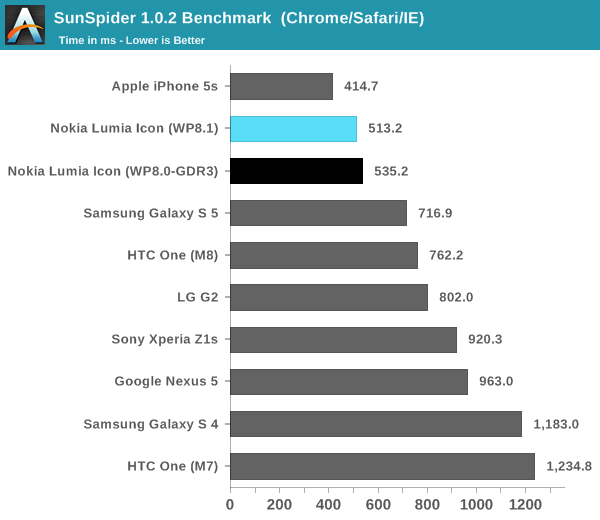
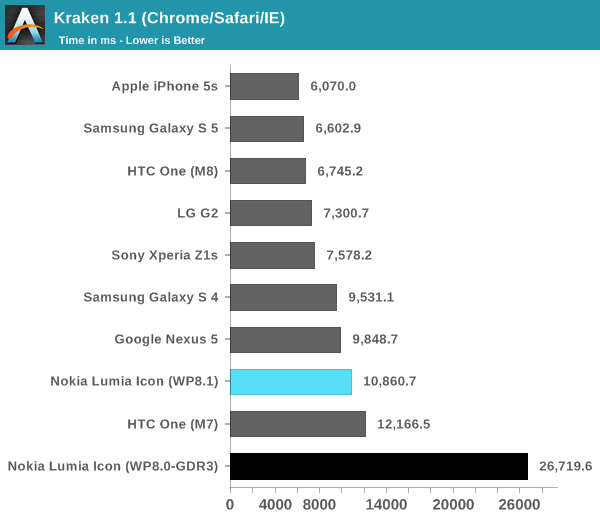
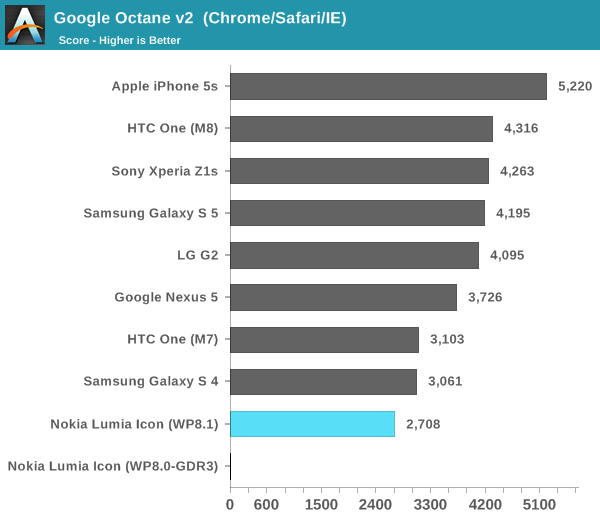
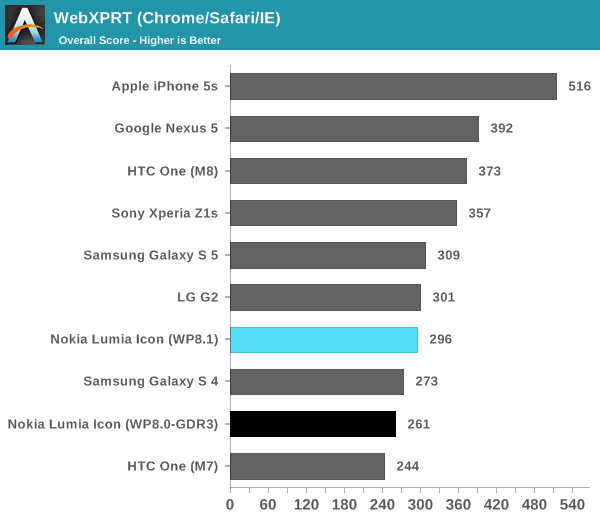
Kraken completes in less than half the time than it did in WP8.0. Octane actually completes now instead of hanging during the asm test, and WebXPRT sees a 13% increase in performance as well. IE11 definitely isn’t the fastest mobile browser on the planet, but it at least moves WP8.1 towards a more modern level of performance. Note in the case of WebXPRT running on the Lumia Icon, we're at performance that's nearly equal to the LG G2 - also using a Snapdragon 800 SoC. That's one of the slowest examples of S800 running Android however. The Nexus 5 by comparison does substantially better - there's still room for improvement in IE11's js performance.
I did notice improvements in actual page load times however it seems to me that there’s a bit of image compression going on even when I have Data Sense disabled which effectively invalidates any comparison results. It’s not clear to me if this is intentional or a bug with the dev preview at this point. In side by side comparisons, Mobile Safari running on the iPhone 5s still manages to load pages faster than IE11 running on the Lumia Icon, despite whatever image compression may be active on the WP8.1 device. It just goes to show you that having the fastest silicon does matter.
IE11 is more compatible than its predecessor. Running HTML5Test the new browser gets a score of 378, compared to 328 in IE10. Chrome for Android and Mobile Safari both score higher however.
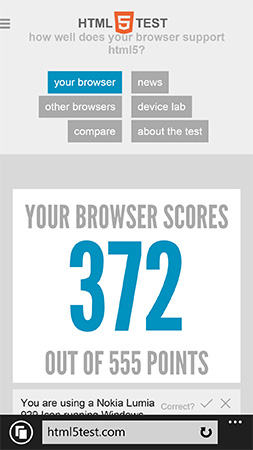
I’ve included a screenshot gallery showing the individual scores, but the new browser wins a lot of points by including support for things like WebGL. Despite adding WebGL support however, I couldn’t get the old aquarium test to actually animate on the device.
IE11 sees functional improvements compared to its predecessor as well. The refresh button at the bottom of the screen has been replaced by a tabs button (you can change it back if you’d like). You can now also swipe right/left to go back/forward through your history in a tab. There’s better YouTube support with IE11 as well. You can now play YouTube videos within an embedded page instead of always being forced out into a full screen mode.
Performance
Since its incarnation, Windows Phone has always been late in adopting high end silicon. It normally wouldn’t be a problem if the platform primarily targeted entry level and mainstream consumers, however for much of its recent life Windows Phone has pursued the high end particularly with Nokia’s flagship devices. The result was a platform that had a high end camera, but with a mainstream SoC. It wasn’t too long ago that Microsoft was parroting the dual-core isn’t necessary for performance and is bad for battery life mantra, but it’s good to see that’s now over with.
Qualcomm remains the sole silicon provider for Windows Phone, which is fine given their position of dominance and the lack of any appreciably better alternatives. With the GDR3 update to Windows Phone 8 Microsoft added support for Snapdragon 800. Although that SoC has since been superseded by the Snapdragon 801, Windows Phone 8/8.1 at least support the highest end mobile silicon family available today.
The Lumia Icon was my first Windows Phone experience on Snapdragon 800, and I have to say it is quite good. Launching and switching between apps is pretty quick and the OS as a whole feels nice and responsive. Having spent the past few weeks in Android and iOS 7.1 land, the Windows Phone 8.1 UI animations seem a bit excessive but no where near as bad as iOS 7.0. The platform overall is quite pleasant to use and never really feels slow, at least with the S800 under the hood.
There are a few native benchmarks available on the Windows Phone Store, which I used to track changes in system performance between WP8 and 8.1. I didn’t find much of a delta between the two platforms:
| Windows Phone 8.1 vs. 8.0 GDR3 Performance | ||||||
| BaseMark OS II | BaseMark X 1.1 (Medium, Overall) | GFXBench 2.7 (T-Rex HD, Onscreen) | ||||
| Windows Phone 8.1 (Lumia Icon) | 1046 | 25536 | 25 fps | |||
| Windows Phone 8.0 GDR3 (Lumia Icon) | 1033 | 24748 | 25 fps | |||
The individual BaseMark OS II scores are worth drilling down on as they expose the improvements in web rendering performance, as well as highlight a slight regression in some of the other areas:
| Windows Phone 8.1 vs. 8.0 GDR3 Basemark OS II Performance | |||||||
| System | Memory | Graphics | Web | ||||
| Windows Phone 8.1 (Lumia Icon) | 921 | 1492 | 1409 | 619 | |||
| Windows Phone 8.0 GDR3 (Lumia Icon) | 1146 | 1474 | 1192 | 566 | |||
The slight drop in system performance (these are mostly CPU bound tests) is unusual, but this is a dev preview of WP8.1. IO performance (memory suite) doesn't change, but graphics and web performance both go up. I suspect there are some improvements on the GPU driver front, which are responsible for the uptick in graphics performance. The increase in web rendering performance is also made evident here.


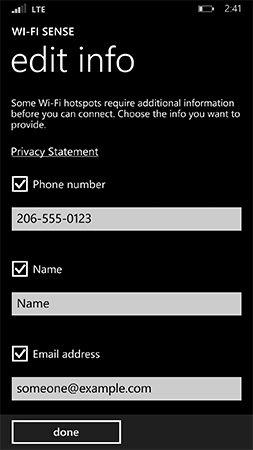
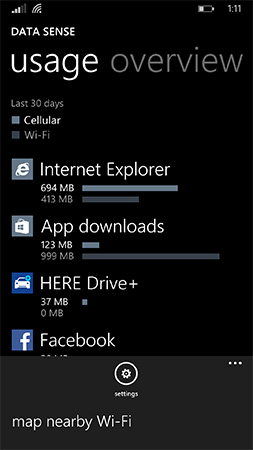
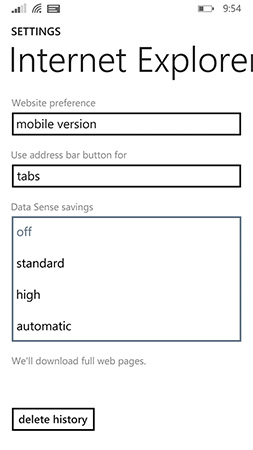
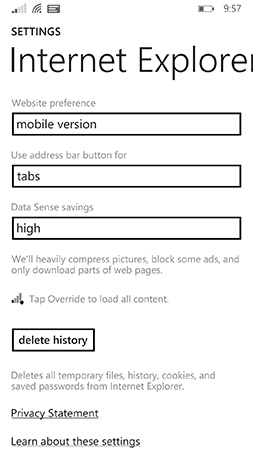
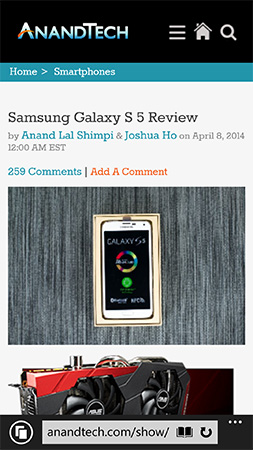














111 Comments
View All Comments
DanNeely - Tuesday, April 15, 2014 - link
In the second set of image tests the no and standard image compression images appear identical. Did MS really manage to squeeze 10% out with no visible impact at all; or did you load the same image twice?EnzoFX - Tuesday, April 15, 2014 - link
So they should be at the bleeding edge in hardware, while focusing on the entry-level? That sounds a bit counter productive to me, but what do I know.I do agree it's great as entry-level, I have a 521, and love it for the basics and little I use it for. I don't want to do anything too complex, if I did I would use a tablet, in which case free tethering on Tmo is a god send.
Penti - Tuesday, April 15, 2014 - link
Their tie in with Qualcomm worked for Microsoft, it's one of the reasons Nokia's mobile business collapsed when they switched as they had been paying and cooperating with other semi-suppliers and much of what they did and their supply network went up in smoke thanks to it. They have already fired 30 000 employees and closed their manufacturing in Europe except for a few holding out in Hungary were most have been sacked. Uprooted how they design and manufacture and most of their supply network. What has survived is manufacturing in India and China, were they mostly has done Series 30/40 type of devices, the sub €50 market.However it didn't look like this for Microsoft's market position for a long time, other SoC-suppliers were pretty prevalent and they did lag even on getting the latest Qualcomm-chips. As Qualcomm-chips come in both new high-end variants and low-end it does make sense to be supported early, regardless of when the mass release is done on the new chip. It also hindered stuff like other screen resolutions. Basically features Nokia's Symbian had in 2010 is what Nokia's WP-phones get now, and some of the limitations Symbian had like semi-fixed resolution got carried on and still applies in 2014. Great for Microsoft which get the only Windows Phone brand for nothing, but for the market as a whole? For NA? Well it's low end devices in Europe and Asia that sells and in the States they don't sell millions of units per year as they – the low-end – haven't caught on over there. High-end is mostly a marketing vehicle for Microsoft I would say. Most of the people that has been proponents early on knew nothing about it's limitations and so those people weren't good ambassadors. Most moved on as it's been about 4 years since Mix 2010. Others like Blackberry moved out of the spotlight but has been able to create whole new platforms within the same time that had most of the necessary features from the first few releases which were out some time ago. Until now, with 8.1 which hasn't made a final release yet, Windows Phone hasn't really been a choice in an enterprise as it's (mobile) management features were worse then BB10, Android and iOS, which all three also supported Exchange much better, had better third-party support for things like sharepoint and lync and so on. S/MIME mail weren't doable until 8.1 for example. They haven't drawn on their strength's that is the rest of the Microsoft family. While they have a mobile Office suit, it's features really isn't any better than third party packages for Android, BB10 or iOS by now and enterprise features or favorites like VBA Macros or really big spreadsheets are a now go. Thus it really doesn't offer any advantages. But now it is at least workable to a much larger extent.
Sabresiberian - Tuesday, April 15, 2014 - link
Thanks for the review of 8.1 and the Icon. I've been wanting an Anandtech treatment because I believe this site is the best at detailing mobile phone hardware and software. You and Brian are also very good at moving prejudices or preferences to the side, expressing opinions as opinions and differentiating them from the facts. Well done.Penti - Tuesday, April 15, 2014 - link
Sadly Universal Apps are overblown, WinRT-framework still has it's limitations and while WinRT has been updated to the same as desktops it still is a two-projects in one solution, and if you don't do an mobile UI, or don't do a Store-UI (desktop metro) then it won't run there. Only part of the code is shared, the .NET version still requires portable class libraries and it's still built as one mobile app and one startscreen app from that project. WinRT (runtime) is sadly a limited abstraction of Win32 rather than anything else and it's still much weaker than iOS SDK or Android NDK/SDK, or Blackberry 10 Native SDK, or Jolla's Sailfish SDK. The phone still runs Win32 programs and the others don't need an API for internal apps such as browsers and a totally different one for developers of third party apps. On Android there pretty much only is Bionic-driven Native apps and apps on the Android framework through Dalvik/ART. WP still has two native frameworks and runtimes underneath it's system. The only thing it does anything better then at a technical level is probably the Bada-LiMo hybrid that is Tizen which is a mix of Bada C++ API's and EFL, which no one can relate to. It kinda is like if Nokia would bring back Symbian C++ API's, which they did replace with Qt the last few years it were around. Microsoft have to settle for the low-end market here, even if they actually can do corporate email now.Duraz0rz - Tuesday, April 15, 2014 - link
"it still is a two-projects in one solution, and if you don't do an mobile UI, or don't do a Store-UI (desktop metro) then it won't run there."Is that a bad thing? There are many instance of iOS or Android apps being developed for the phone and not scaling well to the tablet. You have to make design decisions between the two, especially since the phone is designed to be used (for the most part) in portrait mode, while tablets are designed to be used in landscape.
"it's still much weaker than iOS SDK or Android NDK/SDK, or Blackberry 10 Native SDK, or Jolla's Sailfish SDK."
Why are the iOS or Android SDKs better than the WinRT SDK?
LarsBars - Tuesday, April 15, 2014 - link
Windows Phone lagged behind Android in getting LTE support, but the Lumia 900 launched 5 months before the iPhone 5, which was the first Apple phone to have LTE.UsernameAlreadyExists - Wednesday, April 16, 2014 - link
They even had a review of it. http://www.anandtech.com/show/5724/nokia-lumia-900... Of course, maybe Anand didn't read it :)wrkingclass_hero - Tuesday, April 15, 2014 - link
"It’s no coincidence that the two players that do have that feature also derive revenue from selling advertising against user data."Didn't Apple buy Admob? Admob doesn't collect user data?
MikhailT - Wednesday, April 16, 2014 - link
http://www.google.com/ads/admob/Google owns Admob, so no, Apple didn't buy Admob. Were you thinking of a different company?